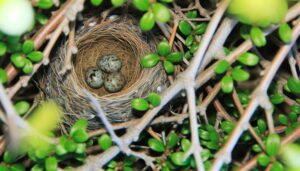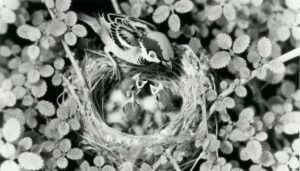5 Key Differences Between House Sparrow and Fox Sparrow
The House Sparrow (Passer domesticus) and Fox Sparrow (Passerella iliaca) can be differentiated by several characteristics. House Sparrows have a robust body, muted brown and gray plumage, and a stout conical bill for seed eating.
They measure roughly 16 cm and nest in human-made structures within urban areas. In contrast, Fox Sparrows exhibit rufous tones, a larger body size of 18-21 cm, and a slender, pointed bill suited for insectivory.
They forage by scratching leaf litter and prefer dense, shrubby environments. Their melodious songs contrast with the repetitive chirps of House Sparrows, offering significant variances in vocalization and habitat preferences.
For further detailed observations, examine additional ecological adaptations.

Key Takeaways
- House Sparrows have muted brown and gray plumage, while Fox Sparrows exhibit rufous tones for forest camouflage.
- House Sparrows possess stout, conical beaks for seeds; Fox Sparrows have slender, pointed beaks for insects.
- House Sparrows are found in urban areas, whereas Fox Sparrows prefer dense, shrubby forest environments.
- House Sparrows nest in human-made structures; Fox Sparrows build ground-level nests hidden under shrubs.
- House Sparrows are sedentary globally, while Fox Sparrows show seasonal migratory shifts within North America.
Physical Appearance
Characterized by variations in plumage, size, and beak morphology, sparrows exhibit a notable diversity in their physical appearance across different species.
Observational data reveal that House Sparrows (Passer domesticus) possess a more robust body structure with a conical bill adapted for seed consumption.
Conversely, Fox Sparrows (Passerella iliaca) are generally larger with a more elongated physique and a pointed bill suitable for foraging insects.
Field studies indicate that the morphological differences in beak shape correlate with dietary preferences and feeding behaviors.
Additionally, the size variation between species is significant, impacting flight dynamics and habitat selection.
These physical characteristics are essential for species identification and understanding their ecological niches within avian communities.
Feather Coloration
Feather coloration among sparrow species varies widely, with pigmentation ranging from the muted browns and grays of the House Sparrow (Passer domesticus) to the striking, rufous tones seen in the Fox Sparrow (Passerella iliaca), illustrating adaptive responses to their respective habitats and behaviors. House Sparrows exhibit a more uniform coloration, which aids in urban camouflage, while Fox Sparrows display a varied palette of rich, reddish-brown feathers, beneficial for blending into forested environments.
| Species | Feather Characteristics |
|---|---|
| House Sparrow | Muted browns, grays, and occasional black streaks |
| Fox Sparrow | Rufous tones, streaked with dark brown |
| Juvenile House Sparrow | Lighter browns with less distinct patterns |
| Juvenile Fox Sparrow | Similar rufous tones but more subdued |
These distinctions underscore the ecological adaptations and evolutionary pressures unique to each species.
Beak Shape
Beak shape in sparrows exhibits remarkable variation, reflecting adaptations to their diverse feeding strategies.
Observations reveal that size and proportion are closely linked to dietary preferences, with granivorous species often possessing stout, conical beaks, while insectivorous species exhibit slender, pointed beaks.
Additionally, beak coloration and pattern can serve as indicators of age, sex, and even health status, contributing to a deeper understanding of their ecological roles.
Size and Proportion
In examining the size and proportion of sparrow beaks, one observes a distinct variability that correlates with their feeding habits and ecological niches.
House Sparrows (Passer domesticus) exhibit a robust, conical beak, optimally designed for cracking seeds. Their beak length averages around 1.1 centimeters, with a proportionate width that ensures efficient processing of hard food items.
Conversely, the Fox Sparrow (Passerella iliaca) displays a more elongated and slender beak, averaging 1.3 centimeters in length. This adaptation facilitates foraging in leaf litter and accessing invertebrates. The ratio of beak length to width in Fox Sparrows is higher, reflecting their dietary preferences.
These morphological differences underscore the evolutionary pressures shaping beak structures to suit specific ecological demands.
Feeding Adaptations
Examining the feeding adaptations among sparrows, one finds that variations in beak shape are intricately aligned with their specific dietary requirements and environmental interactions.
House Sparrows (Passer domesticus) possess stout, conical beaks, adept at cracking seeds, a primary food source in urban settings. This beak morphology allows efficient handling of hard seed coats.
In contrast, Fox Sparrows (Passerella iliaca) exhibit longer, more slender beaks, suited for probing soil and leaf litter for insects and arthropods. This adaptation facilitates access to invertebrates vital for their diet.
Field observations corroborate that these morphological differences are not merely aesthetic but functionally pivotal, enabling each species to exploit distinct ecological niches, thereby reducing direct competition for food resources.
Color and Pattern
Observing the plumage of sparrows reveals significant variations in color and pattern, which play essential roles in camouflage, mate attraction, and species identification.
House Sparrows (Passer domesticus) exhibit a more uniform coloration with a blend of gray and brown, accented by black streaks on their back. In contrast, Fox Sparrows (Passerella iliaca) display a more vibrant palette with rich rufous tones and bold, streaked patterning on their breast and flanks.
The House Sparrow's beak is yellow and robust, suited for seed-cracking, while the Fox Sparrow's beak is more conical and slightly curved, adapted for foraging among leaf litter.
These morphological differences in beak shape and plumage patterns are vital for ecological niche differentiation and survival.
Size and Weight
Among the various species of sparrows, notable differences in size and weight can be observed, providing key identifiers for ornithologists in the field.
The House Sparrow (Passer domesticus) typically measures around 16 centimeters in length, with an average weight between 24 to 40 grams.
In contrast, the Fox Sparrow (Passerella iliaca) is generally larger, averaging 18 to 21 centimeters in length and weighing between 32 to 49 grams.
These measurements are critical for accurate identification, particularly in mixed-species flocks. Field observations reveal that the Fox Sparrow's robust body and slightly elongated shape distinguish it from the more compact House Sparrow.
Such morphological distinctions are invaluable for precise documentation and study of these avian species in their natural habitats.
Vocalizations
In addition to morphological differences, variations in vocalizations among sparrow species provide another layer of identification for ornithologists. House Sparrows (Passer domesticus) produce a series of repetitive chirps, often described as monotonous and mechanical. These calls are typically used for communication within flocks and establishing territory.
In contrast, Fox Sparrows (Passerella iliaca) exhibit more complex and melodious songs, characterized by a series of clear whistles and trills. This intricate vocalization is primarily utilized during the breeding season to attract mates and delineate territorial boundaries.
Field observations reveal that Fox Sparrows' songs vary geographically, an adaptation to different acoustic environments. Recognizing these auditory cues aids ornithologists in distinguishing between these sparrow species, especially in dense, mixed habitats.
Feeding Habits
Feeding habits among sparrow species exhibit noticeable variations, especially in dietary preferences and foraging behavior.
Field observations indicate that while some species mainly consume seeds and grains, others show a more omnivorous diet, incorporating insects and small invertebrates.
In addition, foraging strategies differ notably, with some sparrows displaying ground-feeding tendencies, whereas others are adapted to exploit arboreal food sources.
Dietary Preferences Comparison
Sparrows exhibit a diverse range of dietary preferences, mainly influenced by their species-specific ecological niches and available food sources. The House Sparrow (Passer domesticus) mostly consumes grains and seeds, favoring cultivated crops and urban food scraps. Conversely, the Fox Sparrow (Passerella iliaca) has a more varied diet, including insects, berries, and seeds, reflecting its adaptation to forested and shrubby habitats.
Field observations highlight these dietary distinctions:
- House Sparrows thrive in urban areas, scavenging for discarded food.
- Fox Sparrows forage in forest underbrush, consuming insects and berries.
- House Sparrows have a grain-centric diet due to agricultural proximity.
- Fox Sparrows display a seasonal dietary shift, incorporating more insects in spring.
Understanding these dietary preferences underscores the ecological adaptability of each species.
Foraging Behavior Differences
Examining the foraging behavior of sparrows reveals distinct feeding habits that correlate with their respective dietary preferences and habitats. House Sparrows (Passer domesticus), typically found in urban and agricultural landscapes, exhibit a generalized foraging strategy, exploiting human-provided resources such as grains and food scraps. Conversely, Fox Sparrows (Passerella iliaca), inhabitants of dense shrubs and forest floors, engage in a more specialized foraging approach, scratching the leaf litter to uncover seeds and insects. These behaviors reflect their adaptive strategies to their environments and available food sources.
| Species | Habitat Type | Foraging Behavior |
|---|---|---|
| House Sparrow | Urban, Agricultural | Generalist, human-provided food |
| Fox Sparrow | Dense Shrubs, Forest Floors | Specialist, leaf litter scratching |
These observations underscore the ecological niches occupied by each species, providing insight into their survival strategies.
Nesting Behavior
In what ways do different species of sparrows exhibit unique nesting behaviors that can be observed across various habitats? House Sparrows (Passer domesticus) and Fox Sparrows (Passerella iliaca) offer intriguing contrasts. House Sparrows typically nest in human-made structures, showcasing adaptability to urban environments. They build bulky nests with diverse materials like paper and feathers.
Conversely, Fox Sparrows prefer secluded, ground-level nests within dense vegetation, emphasizing their affinity for natural, undisturbed settings.
- House Sparrow nests: Found in eaves, crevices, or birdhouses.
- Fox Sparrow nests: Hidden under shrubs or grass.
- House Sparrow material: Incorporates man-made items extensively.
- Fox Sparrow material: Utilizes natural elements such as twigs and moss.
These distinctions highlight the adaptive strategies sparrows employ to thrive in varying ecological niches.
Preferred Habitats
Various species of sparrows demonstrate distinct habitat preferences, ranging from urban landscapes to dense underbrush, reflecting their ecological adaptations and survival strategies.
House Sparrows (Passer domesticus), for instance, thrive in anthropogenic settings, such as cities and suburban areas, where they exploit human structures for nesting and readily available food sources.
Conversely, Fox Sparrows (Passerella iliaca) exhibit a preference for dense, shrubby environments, often found in forested regions and thickets. Their habitat choice is closely tied to their foraging behavior, as they primarily scratch the ground for insects and seeds.
Field observations indicate that the dense cover provides both protection from predators and a rich foraging ground, underscoring the species' ecological niche and adaptive strategies.
Geographic Range
Sparrows exhibit a diverse geographic range, with species-specific distributions spanning from the temperate regions of North America to the tropical zones of Central and South America.
The House Sparrow (Passer domesticus) is commonly found in urban and suburban areas across the globe, adapting remarkably well to human-altered environments.
Conversely, the Fox Sparrow (Passerella iliaca) occupies a more restricted range, favoring dense thickets and forested regions primarily in North America.
Field observations highlight notable differences:
- House Sparrows thrive in bustling cities, symbolizing urban adaptability.
- Fox Sparrows, with their preference for isolated habitats, evoke a sense of wilderness.
- Migratory patterns of Fox Sparrows display seasonal shifts, underlining their ecological flexibility.
- House Sparrows exhibit sedentary behavior, emphasizing their dependence on human proximity.
Conclusion
To conclude, the house sparrow (Passer domesticus) and the fox sparrow (Passerella iliaca) showcase avian diversity with unique traits in morphology, coloration, and behavior. These feathered representatives of evolutionary creativity, with their specially shaped beaks and vocalizations, participate in specialized feeding and nesting behaviors within their specific environmental habitats.
Watching these birds, one is amazed by nature's creativity in crafting such detailed distinctions, almost as if daring ornithologists to a never-ending puzzle of 'spot the difference.'






